|
Alma—Siege of Sevastopol—Inkerman—Private Prosser’s V.C.—The
Taku Forts—Changes of Organization and Title—Colours and Battle Honours—Bechuanaland.
There is no need to go into the series of diplomatic blunders
which led up to Great Britain, France, Turkey and (later) Sardinia being
ranged as allies against Russia. We have long enough recognized that our
support of Turkey was, in the late Lord Salisbury’s mordant phrase, “putting
our money on the wrong horse.”
The second battalion left Ireland for Cephalonia in the
Ionian Islands in January 1853, and remained in quarters there until April
1855. It was not until March 1854 that the first battalion sailed from
Plymouth to Gallipoli as a unit in Lord Raglan’s Crimean army, but it was
earlier in getting to work. Lt.-Colonel George Bell (afterwards Sir George
Bell, K.C.B., and Colonel of the regiment) was transferred from the second
battalion to take command and The Royals were in the first brigade of the
third division under Sir Richard England. On June 24 Varna was reached,
where the cholera scourge began to work, and the disembarkation on the soil
of the Crimea took place at Old Fort, Kalamite Bay, on September 14. Five
days later the army moved on Sevastopol and on September 20 was fought the
battle of the Alma. The Royals were in support and practically had no part
in the action. Colonel Bell makes no reference to them in his racy and
informing memoirs, Rough Notes by an Old Soldier.
On the 28th they took up their position on the heights above
Sevastopol and the siege began. The following extracts from Colonel Bell’s
diary give an idea of the winter’s work of the battalion—
“Oct. 10.
"By four in the morning, we had worked under cover, although
the ground was rocky, which gave us double trouble in carrying earth from
the rear to fill up the embankments. We stole away back to the camp
undiscovered before dawn, being relieved by another corps; and so I had the
honour of breaking the first ground before Sevastopol. I had supper about
twelve at night on the ground and in the dark—a bit of black bread, an
onion, some rum and water, and a headache.
“Oct. 17.
"The Russian batteries were firing lazily all night at random
—as much as to say, we are wide awake! 6.30 a.m., was the time appointed for
us to open the ball. Everyone was on the qui vive waiting the signal gun;
all had been in silence on our side during the night; exactly at half-past
six our signal-gun bid them good morning; the time had arrived to return all
civility for nineteen days of incessant cannonade. With right good will, and
an anxious desire to pay off old debts, a scene opened, such as never had
been witnessed since the invention of gunpowder; it was a battle of
artillery—some 2000 great guns opened their mouths of thunder, and iron hail
was showered from each side with the most determined and vindictive desire
to destroy life. The distance was 1,300 yards or thereabouts between us. All
our batteries opened at once; we saw the enemy at their guns, we saw every
fiery flash, and felt their metal; both parties soon got the range, and such
pounding and hissing of shot and shell, cutting through the air with that
velocity that bewilders one in his endeavour to protect his head when the
shot has really passed; flop, they come into the very bank you are leaning
against, and lodge there. A cross-fire now pours in upon us, ploughing along
our in-trenchments; we are enveloped in powder smoke; a breeze from the sea
clears all away; both antagonists in view of each other laying their guns to
the mark; shot coming and going like hail, and shells cracking death and
destruction wherever they explode. No delay beyond laying the guns and
loading. TTie sandbags fly out of their solid beds; the dust rises in clouds
at every volley, and breast-works topple over amongst the infantry. . . .
Look out!—a shot coming; see the flash, the word is hardly spoken, when it
is buried in the bank, or takes the crest of the cover above your head, or
meets a big stone, which turns its course; but they come so quick, ’tis
dangerous to move. Look out again, down, men!—a shell, it falls in the midst
of us and explodes. Oh 1 horrible; seven of my poor fellows—three killed,
and four wounded.
”The evening closes over a day on which some peaceful citizen
would say that hell had broken loose, with all the destructive powers of
darkness. Night comes at last. I shut up my note-book; all is quiet, but the
groans and the moans of the wounded, who are now sent up to camp; the dead
arc covered up; the quartermaster comes down in the darkness with his
barrels of ration rum, a welcome visitor. Pickets are posted, haversacks
opened, breakfast, dinner, and supper, on a bit of pork and onion, and a
biscuit, washed down with a little rum and muddy water; lie down in the
ditch, and asleep in five minutes.”
On November 5, the Russians made a violent surprise assault
on the British lines. It was the Battle of Inkerman. Some of The Royals
moved to support the threatened position : the rest were in the trenches.
Bell can tell the story—
”Before the dawn I was awoke by a heavy cannonade, which did
not disturb me in the least; but on the heels of this tumult came a
pattering of musketry, a sure indication of an attack; I jumped up and
looked out to listen; it was a raw, ugly, drizzling peep o’ day to cool our
courage and damp our powder. I heard the frenzied yell of the Russian
bloodhounds coming on with a quick and thickening fire, buckled on my sword,
and ordered the assembly to sound. What do we muster? '1374, rank and file,
sir; all the rest are in the trenches.’ I marched off to the right by order,
and took up position on the 4th Division ground, Sir George Cathcart having
gone forward to the right with his troops to share in the battle; advanced
across a ravine to the next hill, where we had a 68-pounder battery; it had
been taken by the enemy, and retaken; it was here that the brave Captain Sir
Thomas Troubridge lost both his feet by a cannon-shot, and there he lay in
patient anguish. The Russians made another effort to gain this battery, and
advanced on both flanks, and right up the breast of the hill; dividing my
force, I rushed down to the battery, and sent two companies into the two
ravines, one on each flank, to keep the enemy in check.
“Our position here was of the greatest importance; the enemy
made great efforts to get possession of our ground by turning our left; but
to lose our grasp would have been fatal, so we held on like grim death. It
is no easy matter beating the red devils on any ground, but to try it
up-hill was a forlorn hope; with all their powerful artillery, we crushed
their every effort. The Russians charged our troops with incredible fury and
determination. Ninety guns on the field were pouring death and destruction
into our ranks, firing our tents, and killing our horses; shells exploding
fast and furious. Fresh Russian columns were now advancing, before whom our
slender line gave way, rallied, charged, retired, and returned to the charge
against long odds. The rolling of the musketry continued, to the right,
centre, and left, as the enemy gained ground. They drove their bayonets
through our helpless wounded, who lay at their mercy, like dastard ruffians,
and beat in the heads of our officers while yet alive. One, in particular,
was frightfully abused. He was found on the field after the battle, and
lived on till next day in pain and sorrow. That was the gallant Colonel
Carpenter, who commanded the 41st Regiment. Our men got savage at this cruel
warfare; but yet, although they fell in scores at every volley, they seemed
to multiply. It became a hand-to-hand sanguinary struggle, marked by daring
deeds and desperate assaults; in glens and valleys, in brushwood glades, in
remote dells, the battle went on. At every corner fresh foes met our
exhausted troops, and renewed the struggle, until at length the battalions
of the Czar gave way before the men of England. It was a great and glorious
victory—as much as any victory can be gloriousI”
Bell was mentioned in the Inkerman dispatch and received the
C.B.
Disease proved far more deadly than the Russian fire, for in
five months it slew 321 men, while only seven were killed in the trenches.
The physical condition of those who survived may be judged from a note by
Captain Creagh, of the regiment, who took out a draft during the winter—
”Shortly afterwards, I also went on shore, and my first
impression justified a belief that prizes having been offered to the
dirtiest and most emaciated men and animals in the world, all those likely
to win it had come to Balaklava from every part of the earth.”
The second battalion arrived at Balaklava on April 28 and was
brigaded with the first. On June 18 an unsuccessful assault was made in
which a small party of the first was engaged, and on September 8, during the
last great bombardment of the doomed town, The First Royals took part in the
British assault on the Redan, which failed, while that of the French on the
Malakoff succeeded: the Russians evacuated Sevastopol next day. No more than
4 officers and 52 men of the regiment were killed in action during the whole
siege, and although the colours are inscribed Alma, Inkerman, and
Sevastopol, the Royals never had a real opportunity to show their full
mettle.
It was in this campaign, however, that the regiment secured
its only Victoria Cross during the nineteenth century. It was awarded to
Private Prosser for his distinguished conduct on the following occasions—
”On the 16th June, when on duty in the trenches before
Sevastopol, by pursuing and apprehending (while exposed to two cross-fires)
a soldier of the 88th Regiment in the act of deserting to the enemy.
”On the 11th August, 1855, before Sevastopol, by leaving the
most advanced trench, and carrying in a soldier of the 95th Regiment, who
lay severely wounded, and unable to move.
”This gallant and humane act was performed under a very heavy
fire from the enemy.”
General Kempt had succeeded Sir George Murray as Colonel in
1846 and was followed by Sir Edward Blakeney in 1854.
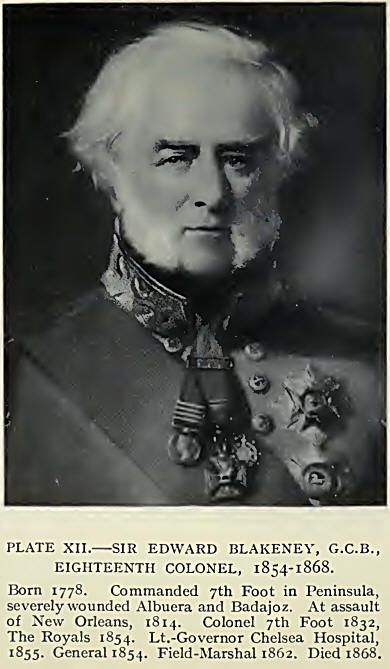
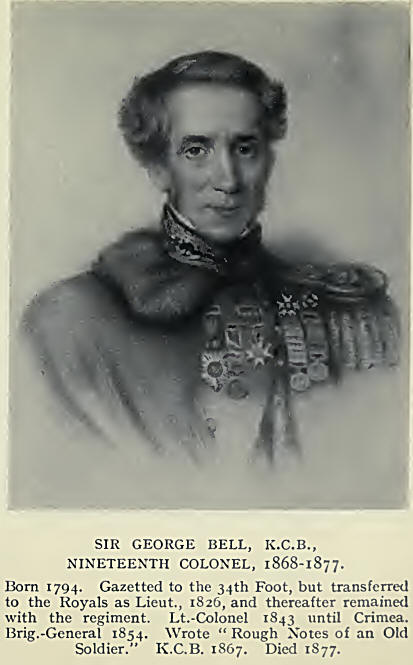
After the Treaty of Peace was ratified in April 1856 the
first battalion returned to Aldershot and was reviewed by Queen Victoria. As
daughter of the Duke of Kent, an old Colonel of the Royals, she always
regarded herself as the daughter of the regiment.
In 1858 the time-honoured constitution of the regiment was
altered by the abolition of the Grenadier and Light Companies, and the
twelve companies of each battalion were made uniform.
In 1857 the first battalion went to India and the second
moved from Malta to Hong Kong in 1858. A detachment of the latter took part
in three expeditions into the interior of China, in which the French
co-operated. The Chinese “ Braves ” had been making trouble for the “foreign
devils” and it was necessary to punish them. Operations in January 1859
resulted in calming the country, but in the naval attack on the Taku forts
in June, Captain McKenna of The Royals, who was aboard the Chesapeake, was
mortally wounded.
Sir Hope Grant’s expedition to the North of China in May i860
was a more important movement. The Royals landed at Pehtang near the mouth
of the river Peiho on August 2, and helped to take the town. They were also
in the attack and capture of the Taku Forts on the 14th.
The next twenty years yield nothing of interest, but in 1881
the scheme of army reorganization abolished the old numbering of the
regiments, and instituted the system of linked battalions on a basis of
territorial titles, attaching to the reconstituted regiment the Militia and
Volunteer battalions of the district. This affected The Royal Scots much
less than the single battalion regiments, which were in
many cases grouped in pairs without any intelligent regard to
their previous history. The Royal Scots became ”The Lothian Regiment (Royal
Scots),” and at the same time they were clothed in trews of a tartan similar
to that worn by the Royal Highlanders. (This was altered in 1901 to the
Hunting Stewart tartan.)
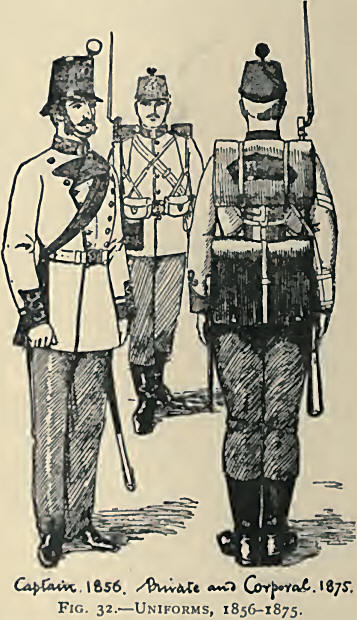
In the following year, however, the title was changed again
to “The Royal Scots (Lothian Regiment).”
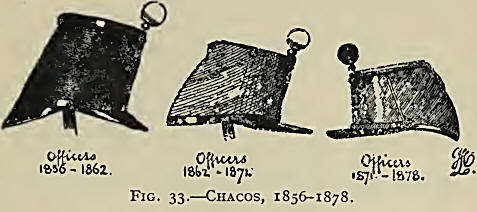
This is a convenient place to refer to the colours of the
regiment, because the oldest now in use by the regular battalions were
received from Queen Victoria in 1876, and are illustrated in Plate XIII. The
colours of the second battalion (Plate XIV) were presented by His Majesty,
King George V, as recently as 1911. The whole question of regimental colours
is full of interest. Captain H. M. McCance has set down everything there is
to be known about those used by The Royal Scots in an appendix to The
Records, and it is not possible to give here more than the briefest outline
of his researches. In the days when The Royals were a Scottish regiment
serving abroad for foreign monarchs, it is safe to assume that they bore on
their flag simply the white cross of St. Andrew. As the company was the
original unit in all military forces, so each carried its own colour as a
rallying point in battle. Dumbarton’s regiment must have looked gay enough
with its twenty-six companies, each headed by an ensign or standard-bearer
carrying the company colour. The first definite mention of the regimental
colours occurs in the journal of Dineley, who saw the lieutenant-colonel's
and major’s companies at Youghal in 1680. His drawing shows the white cross
of St. Andrew on a blue ground, the thistle and crown in gold surrounded by
the circle of St. Andrew, and the motto Nemo me impitne lacessit also in
gold. Drawings of 1693 exist, which show numerous flags captured by Louis
XIV, including three which The Royals lost at the battle of Landen. During
William Ill's reign the number of the colours borne by a battalion was
reduced from twenty-six to three, and in 1707 the Parliamentary Union of
England and Scotland destroyed the preeminently Scottish design of the
regimental colour. The earliest specimens which have survived date from
between 1775 and 1800, and are preserved at Gordon Castle by the Duke of
Richmond and Gordon, to whose family they doubtless came during or soon
after the colonelcy of Lord Adam Gordon. Next in date amongst the surviving
stands of colours are those of the third battalion, which served in the
Peninsular War and was disbanded in 1817. They are deposited in St. Giles’
Cathedral, Edinburgh, and are painted, not embroidered. Of about the same
date are the two stands of colours of the Edinburgh Militia, which have an
honoured resting-place at Dalkeith House. This regiment was the forerunner
of the existing Third (Special Reserve) battalion.
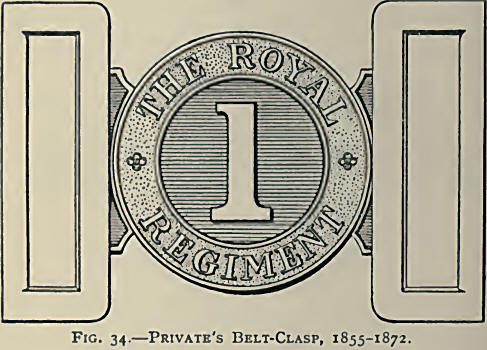
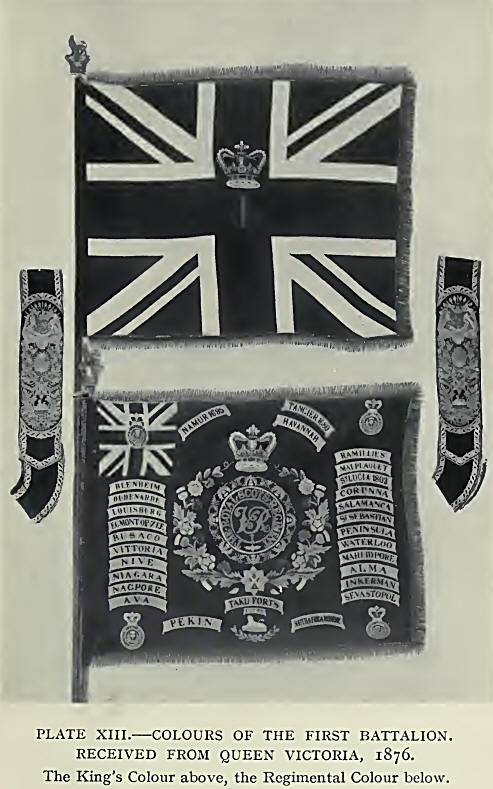
The colours of the fourth battalion were, if regimental
tradition is to be believed, sunk in the river Zoom, after the surrender at
Bergen-op-Zoom in 1814.

These must, however, have been recovered, for they now hang
in the Musee de l’Armee at Paris.
A very faded set of painted colours, which must have belonged
to the regiment between 1812 and 1825, hangs in the Royal Hospital,
Kilmainham. The first battalion’s embroidered colours of 1847 are preserved
in the Town Hall, Inverness, and those of the second battalion, 1847-67, in
St. Giles’ Cathedral, Edinburgh. At the same resting-place are the second
battalion’s colours used from 1867 to 1911. Captain McCance writes of the
present colours as follows—
“The regiment bears ‘the Royal Cypher within the Collar of
the Order of the Thistle, with the Badge appendant. In each of the four
comers the Thistle within the Circle and motto of the Order, ensigned with
the Imperial Crown.’ ‘ The Sphinx superscribed Egypt.’
“ The following honours are also borne on the colours :—
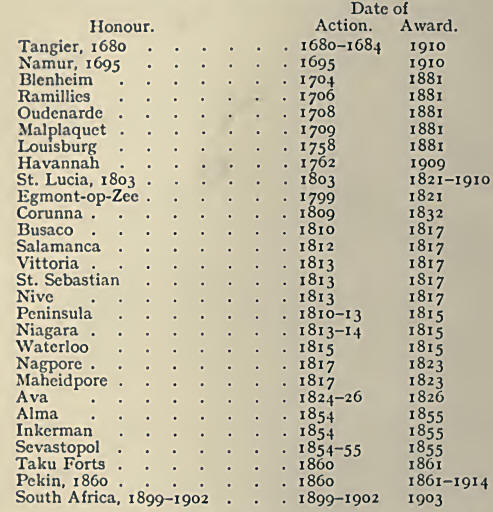
"Note.—' St. Lucia’ was granted in 1821, and the date ' 1803
’ in 1910, to differentiate between the various dates on which the island
had been captured. The badge of a Sphinx, with * Egypt,’ was granted in 1802
to commemorate tnc Conquest of Egypt, 1801. Army Order, 208,of July, 1914,
granted the date i860, in addition to ' Pekin.’ ”
The clothing and equipment of the regiment was considerably
altered after the Crimean War. Chacos were found quite impracticable on
active service, and Kilmarnock forage-caps took their place. The old coatee
disappeared in 1855 in favour of a doublebreasted tunic, and officers’
epaulettes were given up in company with other decorative elements of
uniform. The chaco grew steadily shorter and uglier. Changes, more or less
trivial, were constantly made in cap-plates, belt-plates, etc., and the
various patterns, most of them discarded with as little apparent reason as
led to their adoption, repose peacefully in private collections of such
things.
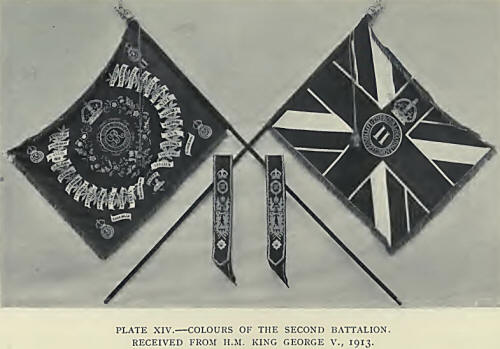
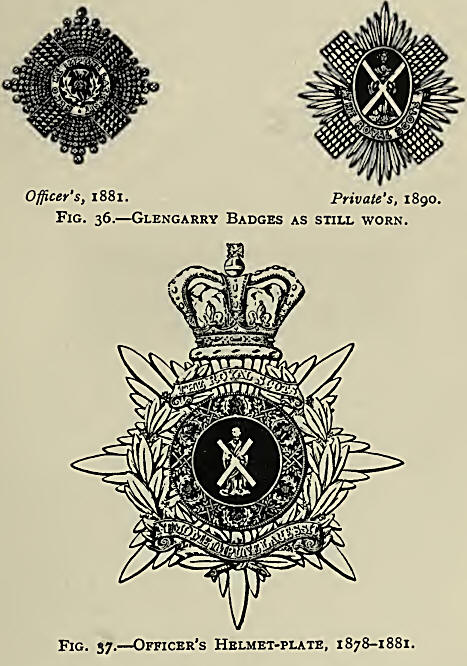
In 1870 came a shattering announcement. Side-whiskers were
ordered to be abolished. The Glengarry superseded the Kilmarnock bonnet in
1874, and the diced border was added in 1880 in order to repair the lack of
national distinctions.
Chacos disappeared in 1878 in favour of the blue helmet, and
this gave the military tailors the chance to alter helmet-plates with
considerable frequency.
The introduction of the Territorial regimental system in 1881
led to many alterations, for the old time-honoured numbers were abolished.
The new doublet was ornamented with the thistle, still worn.
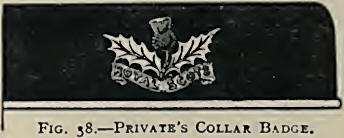
South Africa saw the regiment for the first time at the end
of 1884, when the first battalion arrived in December at Table Bay to serve
with the Bechuana-land Field Force under Sir Charles Warren. Some
filibustering Boers had refused to recognize the British Protectorate over
the Bechuanas, but the display of force was enough and no fighting took
place.
From then until the beginning of the South African War in
1899 there happened nothing worthy of special chronicle, except that General
Raymond, Colonel from 1877 to 1897, was succeeded by Major-General Sir E. A.
Stuart, Bart. |

